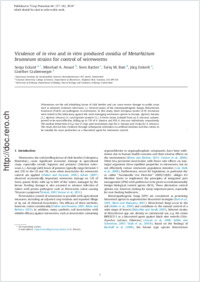Virulence of in vivo and in vitro produced conidia of Metarhizium brunneum strains for control of wireworms
- Eckard, Sonja Agroscope, Institute for Sustainability Sciences, Zurich, Switzerland
- Ansari, Minshad A. Swansea University, College of Science, Department of Biosciences, Singleton Park, Swansea, UK
- Bacher, Sven University of Fribourg, Department of Biology, Unit of Ecology and Evolution, Fribourg, Switzerland
- Butt, Tariq M. Swansea University, College of Science, Department of Biosciences, Singleton Park, Swansea, UK
- Enkerli, Jürg Agroscope, Institute for Sustainability Sciences, Zurich, Switzerland
- Grabenweger, Giselher Agroscope, Institute for Sustainability Sciences, Zurich, Switzerland
-
28.07.2014
Published in:
- Crop Protection. - 2014, vol. 64, p. 137–142
English
Wireworms are the soil inhabiting larvae of click beetles and can cause severe damage to arable crops such as potatoes (Solanum tuberosum, L.). Several strains of the entomopathogenic fungus Metarhizium brunneum (Petch) are pathogenic to wireworms. In this study, three European strains of M. brunneum were tested in the laboratory against the most damaging wireworm species in Europe, Agriotes lineatus (L.), Agriotes obscurus (L.) and Agriotes sputator (L.). A Swiss strain, isolated from an A. obscurus cadaver, proved to be most effective, killing up to 73% of A. lineatus and 83% A. obscurus individuals, respectively. The median lethal time (LT50) was 21 days post inoculation (dpi) for A. lineatus and 14 dpi for A. obscurus. The strain did not lose virulence through subsequent cultivation on artificial medium and thus seems to be suitable for mass production as a biocontrol agent for wireworm control.
- Faculty
- Faculté des sciences et de médecine
- Department
- Département de Biologie
- Language
-
- English
- Classification
- Biological sciences
- License
- License undefined
- Identifiers
-
- RERO DOC 232951
- DOI 10.1016/j.cropro.2014.06.017
- Persistent URL
- https://folia.unifr.ch/unifr/documents/303783
Statistics
Document views: 67
File downloads:
- bac_vvv.pdf: 196
